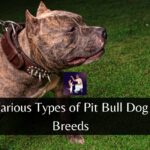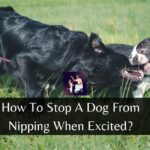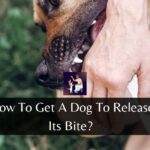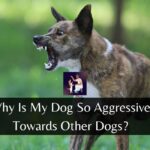A dog’s excitement, often manifested in wagging tails and eager eyes, can sometimes be accompanied by nipping or mouthing behaviors. While this action is typically rooted in playfulness or overstimulation rather than aggression, it can be concerning, especially around children or guests.
Addressing and curbing this behavior is essential for ensuring safe interactions and fostering a well-mannered canine companion.
This article offers insights and strategies to manage and reduce nipping when your dog gets excited.
How To Stop A Dog From Nipping When Excited?
Dogs, especially puppies, often nip or mouth when they’re excited or want to play. While this behavior is natural, it’s essential to teach your dog that nipping humans isn’t acceptable. Here’s a guide on how to stop your dog from nipping when excited:
1. Redirect the Behavior
- Purpose: Dogs, especially puppies, have a natural instinct to mouth and nip. By redirecting this behavior to toys or chewable items, you’re providing an acceptable outlet for their instinct.
- Implementation: Always have a toy on hand, especially during playtime or when greeting your dog after a long day. If they start to nip, immediately offer the toy to divert their attention.
2. Teach Bite Inhibition
- Purpose: Bite inhibition teaches dogs to control the force of their bite. It’s essential for them to understand that human skin is sensitive.
- Implementation: When playing with your dog, if they nip too hard, react with a sharp yelp or “ouch.” This mimics the reactions of their littermates during early play, teaching them that they’ve gone too far.
3. Avoid Overstimulation
- Purpose: Overstimulation can lead to increased excitement, making nipping more likely.
- Implementation: Monitor play sessions. If you notice your dog getting overly excited, introduce short breaks or switch to a calmer activity.
4. Use Calming Signals
- Purpose: Dogs communicate extensively through body language. By using calming signals, you speak their language and ask them to settle down.
- Implementation: If your dog starts to get overly excited, try yawning exaggeratedly, turning your head to the side, or slowly blinking your eyes. These signals can help calm an excited dog.
5. Teach the “Sit” or “Stay” Command
- Purpose: These commands refocus your dog’s energy and attention, providing a momentary break from the excitement.
- Implementation: Regularly practice these commands in various settings. Use them during play or when guests arrive to control excitement levels.
6. Avoid Physical Punishment
- Purpose: Physical punishment can exacerbate aggressive behaviors and doesn’t teach the dog what behavior is desired.
- Implementation: Instead of resorting to physical corrections, use positive reinforcement and redirection techniques.
7. Socialize Your Dog
- Purpose: Socialization exposes your dog to various situations, helping them learn appropriate behaviors.
- Implementation: Regularly introduce your dog to new people, pets, and environments. Monitor their interactions and reward positive behavior.
8. Consistency is Key
- Purpose: Dogs learn best through consistent feedback. If rules change, it can confuse them.
- Implementation: Ensure everyone in the household understands and follows the same guidelines regarding nipping and play.
9. Consider Professional Help
- Purpose: Some dogs may have deep-rooted behavioral issues that require expert intervention.
- Implementation: If basic techniques aren’t working, consult with a professional dog trainer or behaviorist for specialized strategies.
10. Reward Good Behavior
- Purpose: Positive reinforcement strengthens desired behaviors.
- Implementation: Use treats, praise, or play to reward your dog whenever they interact without nipping or when they stop themselves from doing so.
11. Manage the Environment
- Purpose: Controlling the environment can prevent triggers that lead to overexcitement.
- Implementation: If guests are a trigger, consider introducing them to your dog in a controlled setting or using tools like baby gates to manage interactions.
12. Stay Calm
- Purpose: Your energy affects your dog. Staying calm can help de-escalate situations.
- Implementation: If your dog starts nipping, avoid shouting or showing frustration. Instead, use a calm, firm voice and the techniques mentioned above.
Do Dogs Grow Out Of Nipping?
Puppies commonly nip as a form of play and exploration. With age and proper training, most dogs will naturally grow out of excessive nipping behavior. Socialization, obedience training, and consistent corrections can help them understand that nipping is undesirable.
However, some breeds, especially those with strong herding instincts, may retain a tendency to nip, which can be managed through continued training and positive reinforcement. It’s crucial to address nipping early to prevent it from becoming a habit that persists into adulthood.
Bottom Line
Stopping a dog from nipping when excited requires understanding the underlying triggers, consistent training, and positive reinforcement. Techniques such as redirecting their energy, teaching bite inhibition, and reinforcing calm behaviors can be effective in curbing this instinctual response.
It’s crucial to remember that patience and consistency are key; while it might take time, your dog can learn to express their excitement in non-nipping ways with the right approach.
Ensuring safe and positive interactions is beneficial for those around the dog and for the dog’s well-being and social development.
Also Read: 15 Sweet Dog Breeds That Thrive Indoors











